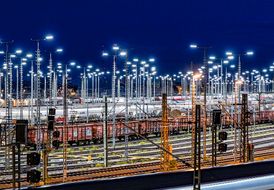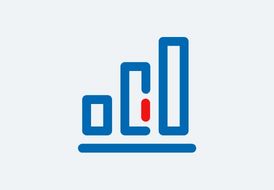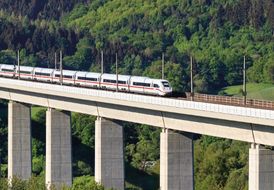Digitalization
Management approach and targets
Focus on digitalization and technology
Our digital and technical strategy is designed to develop an ultra-smart mobility network by 2030 – connected, automated and customer-oriented. In the future, travel should essentially “plan itself” and adapt to changing circumstances in real time in the event of deviations. To this end, our digitalization processes must be understood and designed as an intelligent overall system – a long-term development, with three core tasks under the Strong Rail strategy:
- fully connected,
- self-organized development, and
- making it easier for customers to use mobility services.
In six strategic areas, digitalization and technology are the key to success for the Strong Rail strategy:
- Digital rail operations are making us more robust, for example by using automated timetable planning and scheduling.
- Digital maintenance is making us more efficient, for example as a result of real-time transparency and more proactive planning.
- The digital customer experience is making us more modern, for example by using more efficient travel chains and more intuitive booking options.
- The high availability of rail technology is making us more robust – by increasing the availability of infrastructure and vehicles.
- Flexible rail technology is making us more efficient, for example through the comprehensive modernization of the fleet and infrastructure.
- Green rail technology is making us more modern, for example through emissions-free and environmentally friendly rail operations.
All of these initiatives will help to steadily increase capacity, efficiency and quality. Implementing the digital and technical strategy also requires a culture that supports ideas and plans for a new working environment, and inspires enthusiasm for new technologies and new forms of working (together).
IT infrastructure is the basis for driving digitalization. The digital infrastructure concept for a Strong Rail comprises five components:
- Connectivity: Connectivity is the most basic requirement for data transfer and exchange, because a Strong Rail needs high-speed communication.
- Cloud services: Cloud services help provide dynamic, scalable and on-demand IT services, because a Strong Rail needs resilient IT resources.
- Cybersecurity: The area of cybersecurity will also continue to be improved, because only a secure rail system is a strong rail system. Cybersecurity means comprehensive protection of all (digital) assets, systems, data and processes.
- Development platforms: Our development platforms offer modular services to help speed up the development of software.
- Data management: The objective within data management is to provide tools and standards for the general use of all data within the Group.
By 2030, the goal is to have trained mobility systems to detect, calculate and network automatically and hence, to keep everything permanently up to date. Artificial Intelligence (AI) determines the pace of this by facilitating new ways of managing capacity, eliminating barriers and satisfying requirements before they are even identified and formulated. The vehicles are highly automated, communicate with each other, update themselves independently and report potential defects even before they occur – with new sensors, drones and robots.
DB Data Intelligence Center
Our Data Intelligence Center (DICe) is working on the implementation of Group-wide standardized data management and the innovative use of this data by AI. To this end, DICe leads the Data Council as a Group-wide body for data and AI. It creates the general framework and conditions for making data legally compliant, available and usable.
- The House of Data makes our data searchable through the DB data catalog and also usable, thanks to a modern, automated process. This is based on a standardized data governance policy with clear roles and responsibilities.
- The House of Artificial Intelligence uses available data for innovative projects in order to optimize our core competencies, with a focus on customers and employees.
- The House of 3C (Communication, Community and Change) is dedicated to communication and change management in order to anchor data and AI projects sustainably in the organization and to support employees with process integration.



